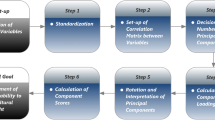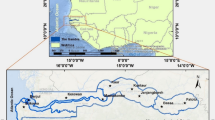Abstract
Drought is one of the main natural disasters affecting regional agriculture, and regional agricultural drought vulnerability assessment is necessary to establish regional drought forecast, monitoring, and early warning mechanisms. The results can provide a theoretical basis for the identification of drought hazard and disaster prevention. In this study, the concept of the overall dispersion and local aggregation of projection points was proposed by Friedman and Tukey (IEEE Trans Comput 23:881–890, 1974), and improvements to the projection pursuit model are proposed here by measuring discrete projection points according to the information entropy. This improved model was applied to assess the agricultural drought vulnerability of 18 counties located in the Sanjiang Plain for 4 years (2004, 2007, 2010, and 2013). Information entropy was shown to provide improved measurements in the data discreteness relative to standard deviations, and the cutoff radius was defined between 0 and ln 2, thus allowing the use of the exhaustion method to determine the cutoff radius. The overall agricultural drought vulnerability in the Sanjiang Plain area shows a downward trend over time. The main reason for this result is the reduced regional sensitivity and the increased drought resistance ability each year. Economic development speeds up the urbanization process, decreasing the proportion of agricultural population and the proportion of agricultural GDP each year and increasing the irrigation index, per capita GDP, rural per capita net income and other indicators each year. These developments decrease the sensitivity of the agricultural system, improve the adaptive capacity, and reduce the vulnerability. Spatially, the vulnerability of various regions shows some differences. The vulnerabilities of Hulin, Luobei, Youyi, and Fuyuan are the lowest and showed a downward trend over time. The sensitivities of these regions were also low; the population density, the proportion of agricultural population and other sensitive indicators were significantly smaller than those for other regions. Furthermore, the drought threat is small, the region has many state-owned farms, the economic situation is good, and the drought resistance ability is strong. The vulnerabilities of Baoqing, Muling, Raohe, and Tongjiang are moderate, with high sensitivities but strong adaptive capacity. The vulnerabilities of Yilan, Jidong, Mishan, Fujin, and Boli have changed greatly, mainly due to the rapid economic development in recent years, increasing the agricultural drought resistance. The vulnerabilities of Tangyuan, Suibin, Jixian, Huachuan, and Huanan are the highest, and with little change, these regions are highly sensitive and prone to drought. In addition, the regional economic development level is relatively low, and the agricultural drought resistance is not high.







Similar content being viewed by others
References
Chen P, Chen X (2011) Evaluating drought vulnerability of agricultural system in Poyang Lake Ecological Economic Zone, China. Trans Chin Soc Agric Eng 27:8–13 (in Chinese)
Cook D, Cabrera J (1993) Projection pursuit indexes based on orthonormal function expansions. J Comput Graph Stat 2:225–250
Dutta D, Kundu A, Patel NR, Saha SK, Siddiqui AR (2015) Assessment of agricultural drought in Rajasthan (India) using remote sensing derived Vegetation Condition Index (VCI) and Standardized Precipitation Index (SPI). Egypt J Remote Sens Space Sci 18:53–63. doi:10.1016/j.ejrs.2015.03.006
Ebrahimi N, Maasoumi E, Soofi ES (1999) Ordering univariate distributions by entropy and variance. Econometrica 90:317–336. doi:10.1016/S0304-4076(98)00046-3
Feng YX, Gao YC, Song X, Tan JR (2013) Equilibrium design based on design thinking solving: an integrated multicriteria decision-making methodology. Adv Mech Eng 2013:953–956. doi:10.1155/2013/125291
Fontaine MM, Steinemann AC (2009) Assessing vulnerability to natural hazards: impact-based method and application to drought. Wash State Nat Hazards Rev 10:11–18. doi:10.1061/(Asce)1527-6988(2009)10:1(11)
Friedman JH, Jerome H (1987) Exploratory projection pursuit. J Am Stat As 82:249–266
Friedman JH, Tukey JW (1974) A projection pursuit algorithm for exploratory data analysis. IEEE Trans Comput 23:881–890
Hall P (1989) On polynomial-based projection indices for exploratory projection pursuit. Ann Stat 17:589–605
He B, Wu J, Lü A, Cui X, Zhou L, Liu M, Zhao L (2012) Quantitative assessment and spatial characteristic analysis of agricultural drought risk in China. Nat Hazards 66:155–166. doi:10.1007/s11069-012-0398-8
Huang H, Lu J (2014) Identification of river water pollution characteristics based on projection pursuit and factor analysis. Environ Earth Sci 72:3409–3417. doi:10.1007/s12665-014-3247-0
Jain VK, Pandey RP, Jain MK (2014) Spatio-temporal assessment of vulnerability to drought. Nat Hazards 76:443–469. doi:10.1007/s11069-014-1502-z
Jiang QY, Fu Q, Xing ZX (2006) Evaluation and regional differences of water resources carrying capacity in Sanjiang Plain. Trans Chin Soc Agric Eng 27:184–190 (in Chinese)
Jin JL, Hong TQ, Wei YM (2007) Projection pursuit based correspondence factor analysis method of watershed non-point source pollution. J Hydraul Eng 39(9):1032–1037 (in Chinese)
Kim DH, Yoo C, Kim TW (2011) Application of spatial EOF and multivariate time series model for evaluating agricultural drought vulnerability in Korea. Adv Water Resour 34:340–350. doi:10.1016/j.advwatres.2010.12.010
Kim H, Park J, Yoo J, Kim TW (2015) Assessment of drought hazard, vulnerability, and risk: a case study for administrative districts in South Korea. J Hydro Environ Res 9:28–35. doi:10.1016/j.jher.2013.07.003
Kruskal JB (1969) Toward a practical method which helps uncover the structure of a set of multivariate observations by finding the linear transformation which optimizes a new index of condensation. In: Milton RC, Nelder JA (eds) Statistical computation. Academic Press, New York, pp 427–440
Li MW, Kang HG, Zhou PF (2012) Urban passenger prediction based on hybrid algorithm of new chaos accelerating genetic algorithm and PPPR model. Syst Eng Theory Pract 32:903–910 (in Chinese)
Li HJ, Li JJ, Kang F (2013) Application of the artificial bee colony algorithm-based projection pursuit method in statistical rock mass stability estimation. Environ Earth Sci 68:2337–2345. doi:10.1007/s12665-012-1912-8
Li Q, Li P, Li H, Yu M (2014) Drought assessment using a multivariate drought index in the Luanhe River basin of Northern China. Stoch Environ Res Risk Assess 29:1509–1520. doi:10.1007/s00477-014-0982-4
Liu XQ, Wang YL, Peng J, Braimoh AK, Yin H (2013) Assessing vulnerability to drought based on exposure, sensitivity and adaptive capacity: a case study in middle Inner Mongolia of China. Chinese Geogr Sci 23:13–25. doi:10.1007/s11769-012-0583-4
Long X, Zhen L, Di SC (2012) Quantitative risk assessment of agricultural drought in the Jinghe watershed of western China. Resour Sci 34:2197–2205 (in Chinese)
Ma Y, Zhao YX, Wu LG, He YX, Yang XS (2015) Navigability analysis of magnetic map with projecting pursuit-based selection method by using firefly algorithm. Neurocomputing 159:288–297. doi:10.1016/j.neucom.2015.01.028
Maasoumi E, Racine J (2002) Entropy and predictability of stock market returns. J Econom 107:291–312. doi:10.1016/S0304-4076(01)00125-7
Murthy CS, Laxman B, Sai MVRS (2015) Geospatial analysis of agricultural drought vulnerability using a composite index based on exposure, sensitivity and adaptive capacity. Int J Disaster Risk Reduct 12:163–171. doi:10.1016/j.ijdrr.2015.01.004
Qin Y, Xu XY, Xu K (2013) Fuzzy evaluation system of agriculture drought disaster risk and its application. Trans Chin Soc Agric Eng 29:83–91 (in Chinese)
Qiu L, Wang WC, Chen XY (2011) Quantitative estimation for vulnerability of agricultural drought disaster using variable fuzzy analysis method. Trans Chin Soc Agric Eng 27:61–65 (in Chinese)
Shannon CE (1948) A mathematical theory of communication. Bell Syst Tech J 27:379–423
Sonmez FK, Komuscu AU, Erkan A, Turgu E (2005) An analysis of spatial and temporal dimension of drought vulnerability in Turkey using the standardized precipitation index. Nat Hazards 35:243–264. doi:10.1007/s11069-004-5704-7
Wang SJ, Hou Y, Zhang XL, Ding J (2003) Comprehensive evaluation method for water resources carrying capacity in river basins. J Hydraul Eng 1:88–92 (in Chinese)
Wang SJ, Zhang XL, Yang ZF, Ding J, Shen ZY (2006) Projection pursuit cluster model based on genetic algorithm and its application in Karstic water pollution evaluation. Int J Environ Pollut 28:253–260. doi:10.1504/Ijep.2006.011210
Wang YB, Wu PT, Zhao XN, Jin JM (2012) Projection Pursuit Evaluation Model: optimizing scheme of crop planning for agricultural sustainable development and soil resources utilization. Clean Soil Air Water 40:592–598. doi:10.1002/clen.201100507
Wu JJ, He B, Lu AF, Zhou L, Liu M, Zhao L (2011) Quantitative assessment and spatial characteristics analysis of agricultural drought vulnerability in China. Nat Hazards 56:785–801. doi:10.1007/s11069-010-9591-9
Wu D, Yan DH, Yang GY, Wang XG, Xiao WH, Zhang HT (2013) Assessment on agricultural drought vulnerability in the Yellow River basin based on a fuzzy clustering iterative model. Nat Hazards 67:919–936. doi:10.1007/s11069-013-0617-y
Xiao F, Chen JG (2012) Fractal projection pursuit classification model applied to geochemical survey data. Comput Geosci 45:75–81. doi:10.1016/j.cageo.2011.10.019
Xu K, Xu XY, Li AH (2013) Assessing agricultural drought disaster risk in Chengde city using stochastic method. Trans Chin Soc Agric Eng 29:139–146 (in Chinese)
Yan FK, Zhang GR, Zhu ZC (2012) Comprehensive evaluation on vulnerability of agricultural drought disaster based on rural household level. J Huazhong Agric Univ (Soc Sci Ed) 1:11–16 (in Chinese)
Yoo C, Kim S, Kim TW (2006) Assessment of drought vulnerability based on the soil moisture PDF. Stoch Environ Res Risk Assess 21:131–141. doi:10.1007/s00477-006-0050-9
Zarafshani K, Sharafi L, Azadi H, Hosseininia G, De Maeyer P, Witlox F (2012) Drought vulnerability assessment: the case of wheat farmers in western Iran. Glob Planet Change 98–99:122–130. doi:10.1016/j.gloplacha.2012.08.012
Zhang D, Wang GL, Zhou HC (2011) Assessment on agricultural drought risk based on variable fuzzy sets model. Chin Geogr Sci 21:167–175. doi:10.1007/s11769-011-0456-2
Zhang Q, Sun P, Li J, Xiao M, Singh VP (2014) Assessment of drought vulnerability of the Tarim River basin, Xinjiang, China. Theor Appl Climatol 12:12. doi:10.1007/s00704-014-1234-8
Zhao XY, Fu Q, Xing ZX (2006) Improvement of projection pursuit model and the application in integrated evaluation of eco-agricultural construction. Trans Chin Soc Agric Eng 5:222–225 (in Chinese)
Zhao J, Jin JL, Zhang XM, Chen YQ (2012) Dynamic risk assessment model for water quality on projection pursuit cluster. Hydrol Res 43:798–807. doi:10.2166/nh.2012.095
Zhao J, Jin JL, Guo QZ, Liu L, Chen YQ, Pan M (2014) Dynamic risk assessment model for flood disaster on a projection pursuit cluster and its application. Stoch Environ Res Risk Assess 28:2175–2183. doi:10.1007/s00477-014-0881-8
Acknowledgments
The authors thank the National Natural Science Foundation of China (Nos. 51179032, 51279031); the Ministry of Water Resources’ Special Funds for Scientific Research on Public Causes (No. 201301096); the Province Natural Science Foundation of Heilongjiang (No. E201241); the Yangtze River Scholars Support Program of Colleges and Universities in Heilongjiang Province; the Heilongjiang Province Water Conservancy Science and Technology project (No. 201318); and the Prominent Young Person of Heilongjiang Province (No. JC201402).
Author information
Authors and Affiliations
Corresponding author
Rights and permissions
About this article
Cite this article
Pei, W., Fu, Q., Liu, D. et al. Assessing agricultural drought vulnerability in the Sanjiang Plain based on an improved projection pursuit model. Nat Hazards 82, 683–701 (2016). https://doi.org/10.1007/s11069-016-2213-4
Received:
Accepted:
Published:
Issue Date:
DOI: https://doi.org/10.1007/s11069-016-2213-4




